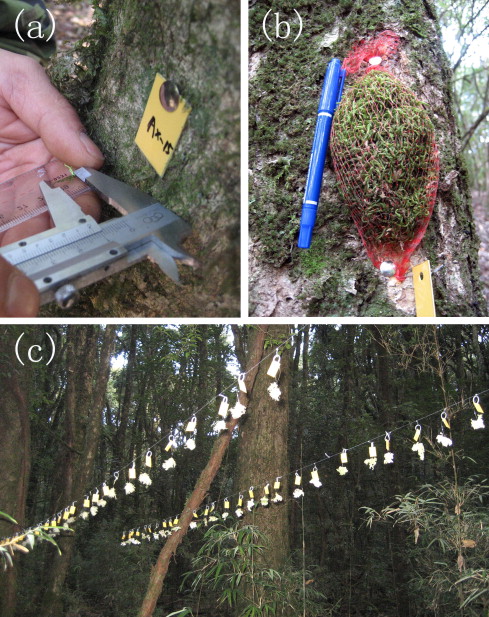
Among the few studies that assessed the potential impact of climate change on non-vascular epiphytes, most evidence has been derived from modeling work. Previous empirical studies have focused on either range shifts or community dynamics, with few addressing the specific influences related to climate change on the growth and health of non-vascular epiphytes.
Prof. LIU Wenyao and his research team of Xishuangbanna Tropical Botanical Garden conducted a field experiment to assess the potential impacts of predicted climate change on the growth and health of four common non-vascular epiphytes [Bazzania ovistipula (Steph.) Mizut.; Trismegistia undulate Broth. et Yas; H. flabellatum; Nephromopsis pallescens (Schaer.) Y.S. Park] at three elevations in a subtropical montane moist evergreen broad-leaved forest in southwest China. The study was conducted in the Xujiaba region (23°35′–24°44′N, 100°54′–101°01′E), at 2000–2600m altitude.
In the study, they transplanted three common cryptogamic epiphyte species (two bryophytes, one lichen) from high elevation to medium and low elevation sites and monitored their growth and health at regular intervals. Another bryophyte species was monitored in situ at the three translocation sites.
Results of the microclimate measurement confirmed that air temperature decreased, but water availability increased with altitude rising. They inferred that non-vascular epiphytes would respond much sooner to changes in the water cycle, especially dryness, than their terrestrial counterparts in the subtropical montane moist forests of south-western China.
The chlorolichen N. pallescens showed the most significant and largest differences in growth and health after having been exposed to warmer, drier conditions. The researchers thus proposed that N. pallescens could be a potential climate change indicator in the subtropical montane moist evergreen broad-leaved forest.
The researchers suggested that conservation efforts to maintain the stability and resiliency of tropical or subtropical montane forest ecosystem to climate change should include epiphyte communities.
The study entitled "Response of non-vascular epiphytes to simulated climate change in a montane moist evergreen broad-leaved forest in southwest China" has been published in Biological Conservation, 152(8):127-135.

(a) Shoot elongation measurement of Homaliodendron flabellatum in the field. (b) Photograph of net bag transplantation method of epiphytic bryophytes. (c) Photograph of pendent transplantation method of epiphytic lichens. (Images by SONG Liang)

86-10-68597521 (day)
86-10-68597289 (night)

86-10-68511095 (day)
86-10-68512458 (night)

cas_en@cas.cn

52 Sanlihe Rd., Xicheng District,
Beijing, China (100864)

